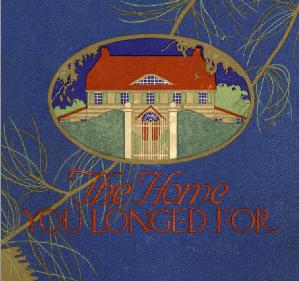THE term "Colonial House," as we are accustomed to use and hear it, may suggest either the actual workmanship of early Colony times, or a present day production of the early American form. The use of the word has become so broad and general, owing to the popularity of the type, whether of good or bad examples, that it has come to mean almost any house. Properly, the expression means the old specimen, and "modern Colonial" implies precisely what is said, namely, the old type adapted to modern requirements with all the simple, quaint, quiet, restful dignity and homelike charm, together with masterly proportions and exquisite detail characteristic of the type. Without these qualities, no modern house can attain the high excellence of design which characterized the earlier standards. When our forefathers crossed the Atlantic to our shores, they brought with them as part of their religion a true conception of the meaning of hearth and home. In their minds the fine arts were not uppermost, for they were forced to depend largely upon their own ingenuity for inspiration. To them, however, their homes exemplified certain domestic virtues, and while the fine spirit of home life which was theirs has since lost some of its true value, there still remains in the normal man that same love of home. The familiar old farm house of New England that one sees today along the country roads and village streets is the venerated and much thought of Colonial type of traditional expression, begun with the origin of our country and passed down to us as the most useful heirloom of all that we have had from those earlier times. These houses were staunchly built as well as designed for charm and convenience, so that we are not only persuaded to preserve and copy them, but wish to perpetuate their ideals in our present day work. Those early builders had the valued knowledge of well defined truths in architecture such as the Greek and Italian, in motifs which appear both obscurely and clearly in this period. These few old world standards, rightly employed, have become completely molded to fit our present conditions, so that the product which we now know as the real Colonial type is our own intuitive conception of earlier design. This influence of early Colonial feeling has so persisted through subsequent work that original and later productions are looked upon as architecturally synonymous, and our modern examples are therefore not imitations, but rather developments of early principles. Our national life underwent great changes during the period between the classic perfection and splendid influence of which McIntyre was the principal exponent, and that later period of decadence, the so-called mid-Victorian era. It is only in comparatively recent years that the more discerning public has turned back with appreciation and respect to the beauty of the early Colonial and Georgian traditions. Architecture can no more invent a new style than literature can create a new language. All that remains therefore, is for the architect to set his skill to solve new problems with old material and from the same elements create new com-positions. Brilliant forms of proportions and details are characteristic of a high standard of Colonial work, and in a new arrangement of such forms there is room for infinite originality. We do not want new forms, but rather new light on the old as well as a new perception of their possibilities, which in a delightful and easy fashion have been wrought into those unpretending examples which rank very high in the country house work of today. Our better houses, the work of those imbued with the rightful spirit for the old forms which we so admire, have passed far beyond the stage of merely conscientious copying. Many perhaps, are no doubt seemingly mere imitations of early types, while actually they are well adapted to prevailing modern tastes and custom. The imaginative homebuilder may attempt to visualize the home of his dreams, but as a rule lie must first see some material suggestion before his air castle takes definite form. Then it is that his mental creation of "the white or soft gray exterior, green blinds, surrounding elms, foliage, shrubbery and bordered garden walk" becomes the reality to which he can refer in developing his own home plans. Sentiment such as this is bound to be an all-important factor in molding the spirit of the present-day home lover. With such a rich inheritance handed down to us, why should not all our homes be of this sort, examples of these splendid former types which were fashioned on sound principles beyond reason for change of design and possessing an artistic grace from which future generations may gather lasting inspiration - " made to live in and adorned to please" - such should be the enduring qualities of the typical American home of today? |
|||||
 |
|||||
"THE HOME YOU LONGED FOR, designs by Roberrt Seyfarth - Architect" was published in 1918 by the Arkansas Soft Pine Bureau. It contained photographs and floor plans for 18 houses designed by Robert Seyfarth from approxiamtely 1910 until 1917. The text reproduced here is the introduction to the book. It contains comments by the architect about his work and views on architecture from this early part of his career. |
|||||